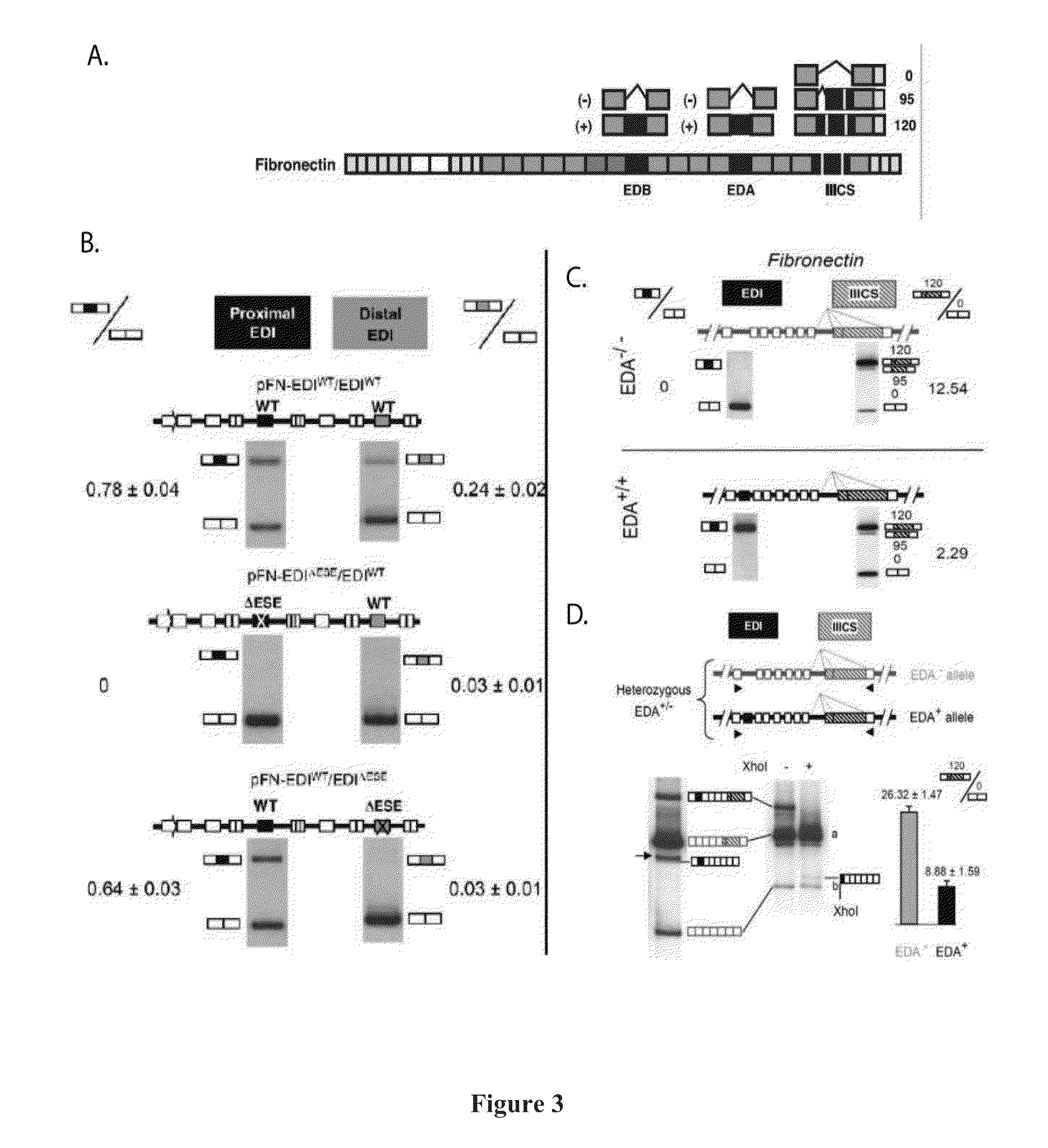Deducing Exon Connectivity by RNA-Templated DNA Ligation/Sequencing
a technology of rna-templated dna and exon connectivity, applied in the field of gene expression, can solve the problems of difficult identification and study of distal regions, the inability to detect the potential influence of one splicing event on subsequent splicing events in the same transcript, and the fragmentation of potentially long molecules
- Summary
- Abstract
- Description
- Claims
- Application Information
AI Technical Summary
Benefits of technology
Problems solved by technology
Method used
Image
Examples
example i
The Multiple Ligamer Exon Connectivity Assay
[0256]This example demonstrates protocol showing how a sequence of the mRNA strand may be captured in a ‘looped out’ conformation through hybridization to the two complementary ligamer regions. See, FIG. 5.
[0257]In general, the method comprising the steps of:[0258]1) Total RNA may be extracted from sample using standard protocols (TriReagent, TriZol, etc).[0259]2) Total RNA is enriched for poly(A) sequences using Oligo dT purification.[0260]3) Ligamers targeted to transcript region of interest are synthesized with appropriate 5′ phosphates and common PCR sequences.[0261]4) Pool of ligamers is mixed with transcript at desired concentration.[0262]5) Sample is heated to relax RNA secondary structure, while maintaining poly(A) hybridization (i.e. between 55° C. and 60° C.). This is followed by overnight hybridization at 15° C. below the normalized Tm of ligamers.[0263]6) Ligase is added at desired concentration and allowed to catalyze ligation...
example ii
Ligamer Design
[0268]The 5′ and 3′ most sequences of a target sequence (ex. exon or multiple exons) were obtained from online databases (ACEview, UCSC, etc.). The Tm of these sequences was normalized to 60° C.±5° C. according to nearest-neighbor rules (Xia, SantaLucia et al. 1998) by adding or removing target nucleotides. Most sequences fell between 12 and 25 nucleotides of hybridization. After assembling target regions, matching sequences (i.e. the 5′ and 3′ edge sequences of a specific exon) were combined, and a short linker sequences was included between them (i.e., for example, ACTACT). With the full sequence now assembled, the reverse complement was taken, ligamers requiring 5′ phosphorylation for subsequent ligation were marked, and ligamers were ordered in a 96 well format (Integrated DNA Technologies). Ligamers were reconstituted at 1 uM into ‘sets’ targeting specific areas of compression and subsequently diluted for use in the SeqZip protocol.
example iii
Exon Connectivity Determination Method (e.g., SeqZip)
[0269]Total RNA was isolated from cell line or tissue using according to the manufacturer's instructions (TriReagent, MRC Inc.). Poly(A) RNA was isolated using a commercially available kit. (Poly(A)Purist™ MAG, Ambion (AM1922)). Poly(A) RNA was not eluted from magnetic beads, and after the last wash step, beads were aliquoted into appropriate amounts and reconstituted in hybridization buffer (60 mM Tris-HCl pH 7.5 @ 25° C., 1.2 mM DTT 2.4 mM MgCl, 480 uM ATP) including 10 nM of all appropriate ligamers.
[0270]Hybridization was performed in a thermocycler by heating samples to 62° C. for 5 minutes and cooling to 45° C. in 3° C.×10 minute increments. Samples were left at 45° C. for 1 hour, then cooled again in 3° C.×10 minute increments until 37° C. was reached. Samples were left at 37° C. until enzyme was added. T4 RNA ligase 2 (NEB, MO239) was added to compose 10% of final volume (i.e., for example, 5 uL in 45 uL of previous sample...
PUM
| Property | Measurement | Unit |
|---|---|---|
| Electric charge | aaaaa | aaaaa |
| Electric charge | aaaaa | aaaaa |
| Digital information | aaaaa | aaaaa |
Abstract
Description
Claims
Application Information
 Login to View More
Login to View More - R&D
- Intellectual Property
- Life Sciences
- Materials
- Tech Scout
- Unparalleled Data Quality
- Higher Quality Content
- 60% Fewer Hallucinations
Browse by: Latest US Patents, China's latest patents, Technical Efficacy Thesaurus, Application Domain, Technology Topic, Popular Technical Reports.
© 2025 PatSnap. All rights reserved.Legal|Privacy policy|Modern Slavery Act Transparency Statement|Sitemap|About US| Contact US: help@patsnap.com



